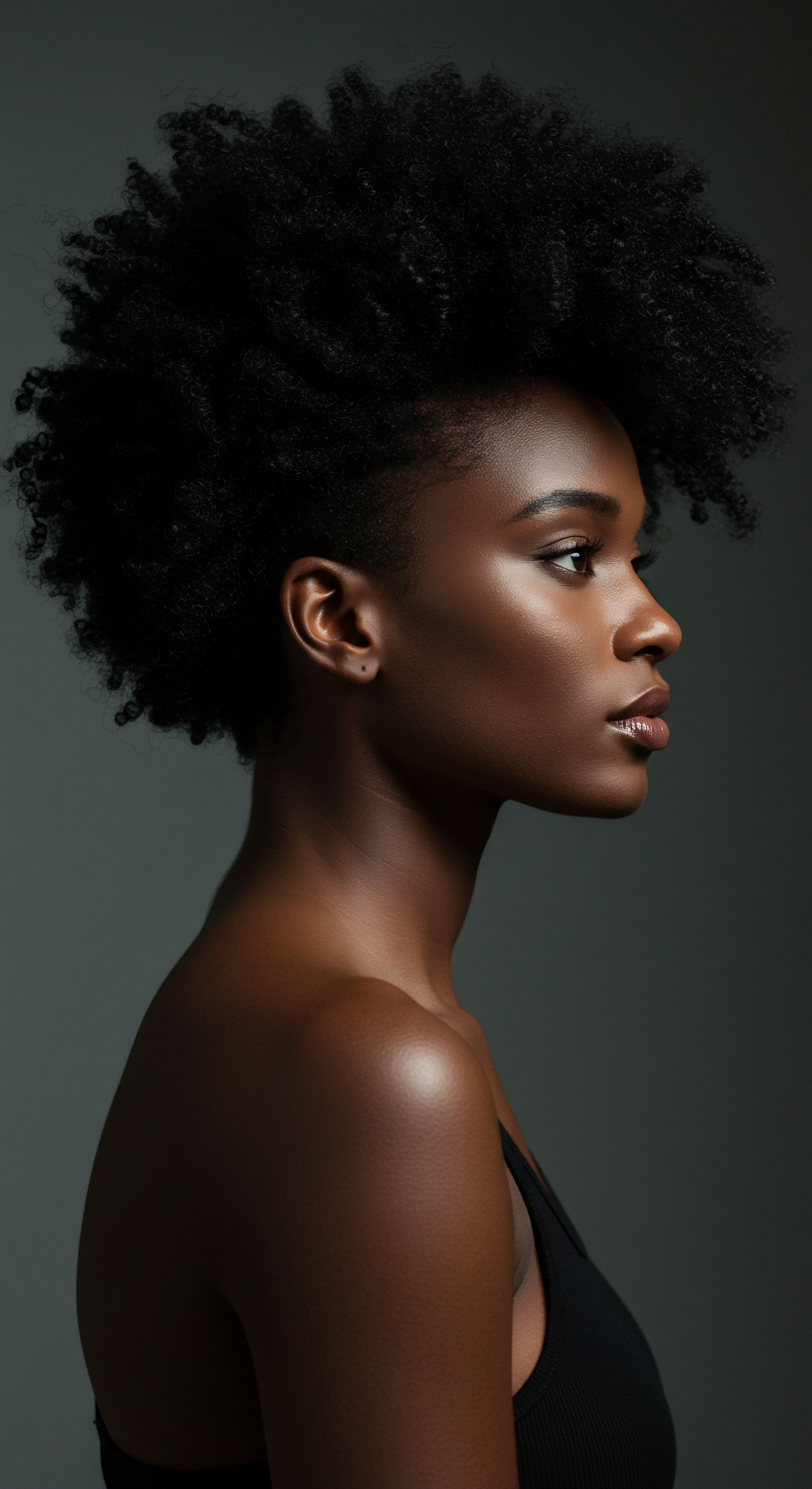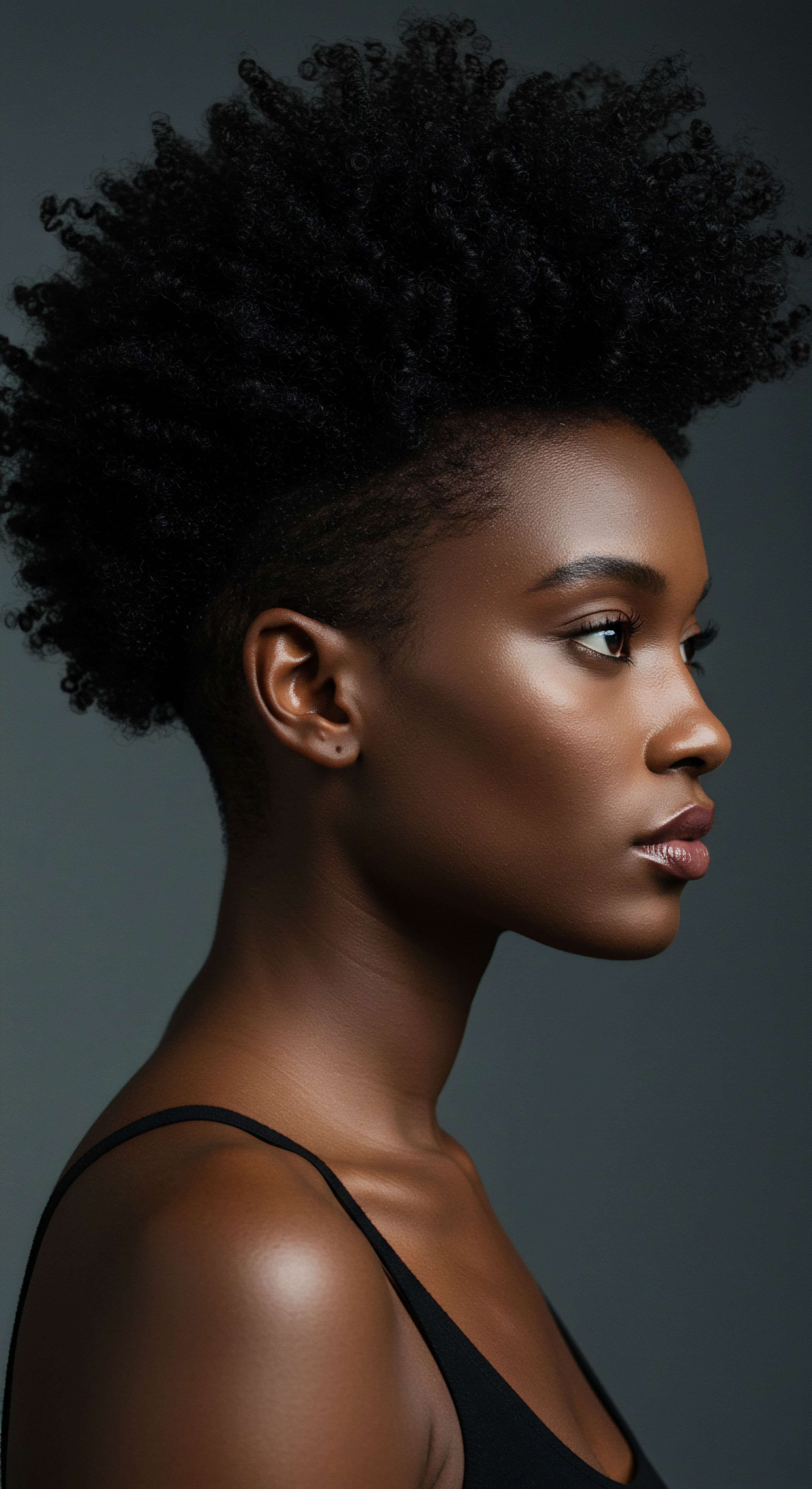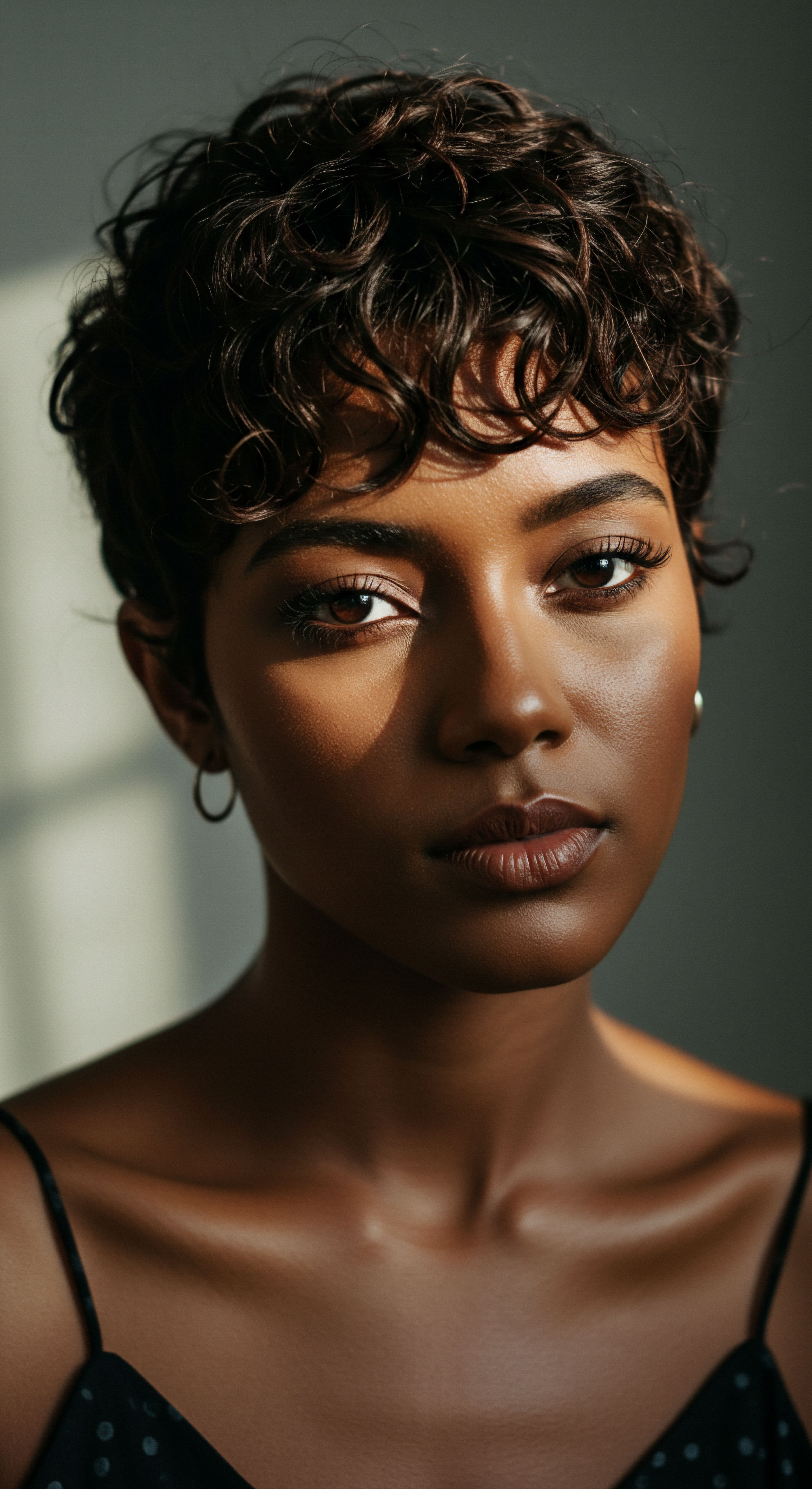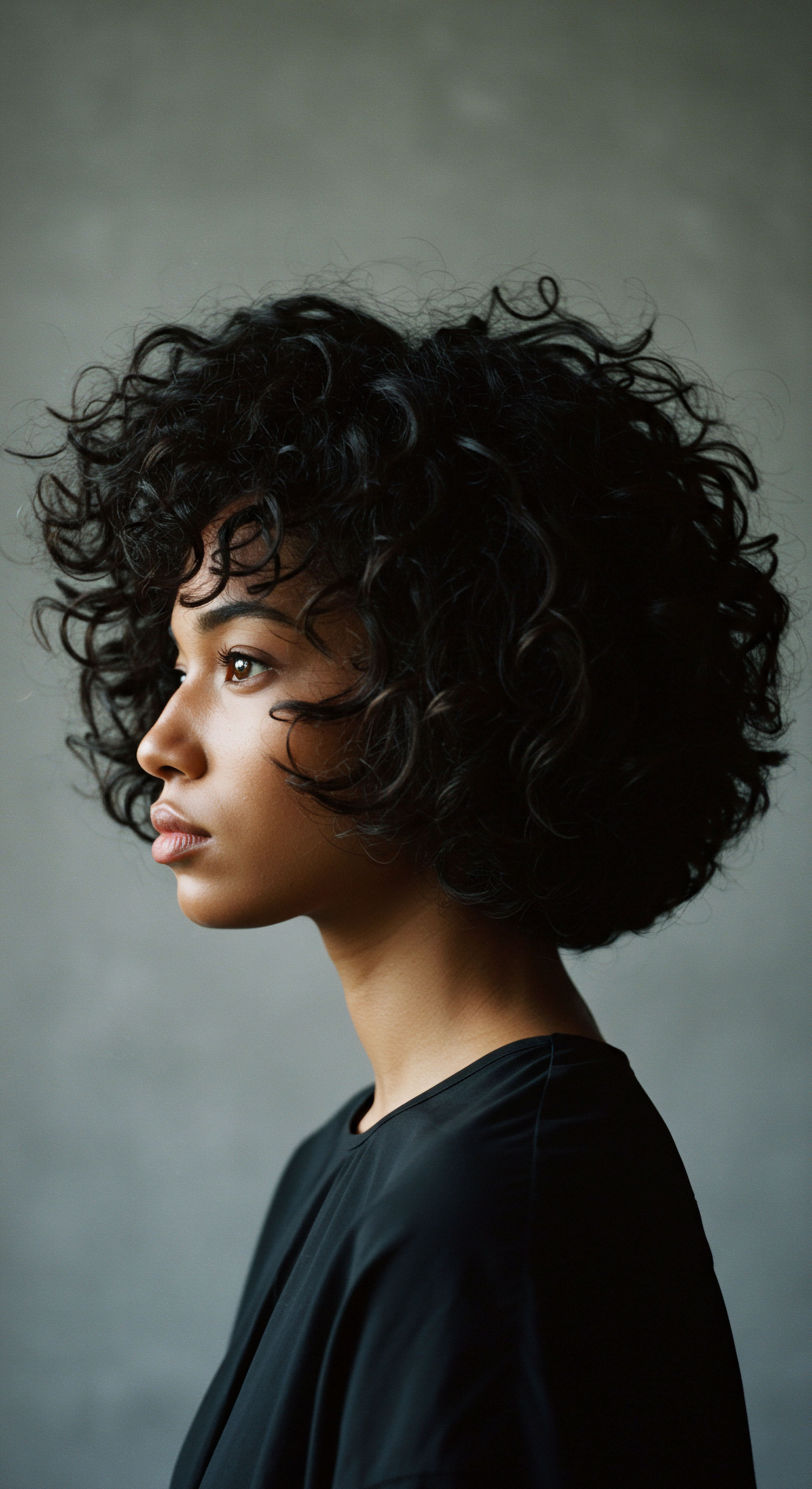
Roots
The whisper of night, a time for the world to settle into slumber, holds a particular significance for those with textured hair. It is not merely a period of rest, but a profound opportunity for restoration, a quiet act of devotion to the delicate strands that grace our crowns. Too often, the very surfaces we choose for comfort inadvertently conspire against the vitality of our coils and kinks, leaving them parched and vulnerable to the slightest disturbance.
This exploration invites us to consider the foundational truths of our hair’s structure and how its inherent qualities demand a conscious partnership with the materials that cradle it through the darkest hours. We seek to understand, with a gentle yet unwavering gaze, the very essence of what makes textured hair distinct and, by extension, what it truly needs to thrive under the cloak of night.

Understanding Textured Hair’s Delicate Architecture
The morphology of textured hair is a marvel, a testament to nature’s boundless creativity. Unlike its straighter counterparts, each strand of textured hair typically possesses an elliptical or flattened cross-section, causing it to grow in a helical, often spiraling pattern. This unique shape, coupled with an uneven distribution of keratin along the hair shaft, creates natural points of weakness. The cuticle, the outermost protective layer of the hair, does not lie as flat and smooth as it might on a straight strand.
Instead, these scales are often slightly raised, particularly at the curves and bends of the coil. This raised cuticle, while contributing to the hair’s characteristic texture and volume, also presents a paradox ❉ it offers more surface area for friction.
This architectural distinction means textured hair is inherently more susceptible to moisture loss and mechanical damage. The natural oils produced by the scalp, known as sebum, struggle to travel down the winding path of a coily strand, leaving the ends particularly vulnerable to dryness. When these dry, raised cuticles encounter abrasive surfaces, the friction can cause them to lift further, snag, and eventually break. This is a quiet, nightly battle often waged unknowingly, resulting in frayed ends, tangles, and a dullness that belies the hair’s natural luster.

The Language of Hair Protection
To speak of protecting textured hair is to speak of preserving its intrinsic moisture, maintaining its structural integrity, and honoring its natural curl pattern. The goal is to minimize friction, reduce moisture evaporation, and prevent tangling. These three pillars form the bedrock of effective nighttime care. Without a conscious effort to address these vulnerabilities, even the most diligent daytime regimen can be undone by the seemingly innocuous act of sleep.
Nighttime care for textured hair is a quiet, essential act of preservation, guarding against friction, moisture loss, and tangling.

Why Does Textured Hair Need Special Nighttime Care?
The need for specialized nighttime protection stems directly from the inherent characteristics of textured hair. Its unique structure makes it prone to dryness and breakage, and the simple act of tossing and turning during sleep can exacerbate these issues. Consider the constant rubbing against a pillowcase for six to eight hours. This continuous abrasion, particularly on absorbent materials, acts like a slow, steady erosion, stripping away vital moisture and causing the delicate cuticle layers to fray.
- Friction against rough surfaces causes the hair cuticle to lift, leading to frizz and breakage.
- Moisture Evaporation occurs when absorbent fabrics draw hydration away from the hair, leaving it dry and brittle.
- Tangles are more likely to form when hair is allowed to move freely and rub against itself or abrasive surfaces.

A Glimpse into Hair’s Hydration Dynamics
Hair hydration is a delicate balance, influenced by both internal factors and external conditions. The lipid layer on the hair’s surface, along with the natural moisturizing factors within the cortex, work to retain water. When hair comes into contact with materials that possess a high affinity for water, a phenomenon known as hygroscopy, moisture is actively drawn away from the hair shaft. This is particularly problematic for textured hair, which, as previously discussed, often struggles with natural sebum distribution and a more open cuticle structure.
A study published in the Journal of Cosmetic Science examined the water vapor sorption and desorption characteristics of different hair types, revealing that highly porous, textured hair tends to lose water more rapidly than less porous, straight hair under varying humidity conditions. This scientific observation underscores the importance of choosing sleep surfaces that do not contribute to this already accelerated moisture depletion.

Ritual
As the day surrenders to dusk, and the world outside begins its quiet descent into slumber, a different kind of preparation begins for many with textured hair. This is not merely about tidying up before bed; it is a ritual, a deliberate choreography of care that acknowledges the hair’s needs beyond the waking hours. It is a moment to transition from the active engagement of styling to the passive, yet potent, act of protection.
The choice of fabric that cradles our strands through the night is a cornerstone of this ritual, a decision that can dramatically alter the morning’s narrative from frustration to ease, from damage to sustained vitality. Let us consider the practical wisdom that guides this nightly practice, moving from the elemental understanding of hair to the tangible choices that guard its delicate beauty.

The Silk Standard Why It Stands Apart
When discussing the optimal nighttime fabric for textured hair, silk invariably rises to the forefront. Its reputation is not born of fleeting trend but from its unique properties that align perfectly with the needs of delicate strands. Silk is a natural protein fiber, spun by silkworms, composed primarily of fibroin. Its smooth, tightly woven surface presents minimal friction to the hair shaft.
Unlike cotton, which has a rough, absorbent surface that can snag hair and draw out moisture, silk allows hair to glide effortlessly across its surface. This reduction in friction significantly minimizes breakage, tangles, and the dreaded “bed head” that often plagues textured hair.
Beyond its unparalleled smoothness, silk possesses a remarkable ability to retain moisture. While it is not entirely non-absorbent, its protein structure means it does not strip hair of its natural oils and applied products to the same extent as other common fabrics. This preservation of hydration is paramount for textured hair, which is naturally prone to dryness. The hair’s natural moisture barrier remains intact, leading to softer, more pliable strands come morning.

Is All Silk Equal for Hair Protection?
The world of silk offers various qualities, and discerning between them is key to maximizing protective benefits. The measure of silk quality is often expressed in “momme” (mm), which refers to the weight of the silk fabric. A higher momme count indicates a denser, more durable, and generally smoother fabric. For hair protection, a momme count of 19-25 is generally considered ideal for pillowcases and bonnets.
Lower momme silks might be less durable and offer less of the desired glide. The type of silk also matters, with mulberry silk being the most common and highest quality for textile use, known for its long, uniform fibers.
Mulberry silk, with a momme count of 19-25, offers superior hair protection due to its smooth surface and moisture-retaining properties.

Satin The Accessible Ally
For those seeking an alternative to silk, satin emerges as a commendable second choice. It is important to note that satin is a weave, not a fiber. While silk is a natural fiber, satin can be woven from various materials, including polyester, nylon, or even silk itself (though silk satin is simply a type of silk). When people refer to “satin pillowcases” as an alternative to silk, they are almost always referring to polyester satin.
The primary benefit of satin, like silk, lies in its smooth surface. The way the fibers are woven creates a slippery texture that reduces friction on hair, thereby minimizing breakage and tangles. While polyester satin does not possess the same moisture-retaining properties as natural silk (it can actually be less breathable and potentially cause scalp sweating for some), its smooth surface still offers a significant improvement over cotton. It is a more budget-friendly option that still delivers tangible benefits for hair health, making it a popular and practical choice for many.
Choosing between silk and satin often comes down to personal preference, budget, and specific hair needs. For the ultimate in luxury and hair health benefits, silk remains the gold standard. For a more accessible option that still provides considerable protection against friction, satin is a reliable choice.
| Fabric Type Mulberry Silk |
| Key Characteristics Natural protein fiber, smooth, breathable, luxurious feel, varying momme counts. |
| Hair Benefits Minimizes friction, prevents breakage, retains hair moisture, reduces frizz, maintains styles. |
| Considerations Higher cost, requires delicate care. |
| Fabric Type Polyester Satin |
| Key Characteristics Synthetic fiber, smooth weave, glossy appearance, more affordable. |
| Hair Benefits Reduces friction, prevents breakage, minimizes tangles, more accessible. |
| Considerations Less breathable than silk, may not retain moisture as effectively, can feel warmer. |
| Fabric Type Cotton |
| Key Characteristics Natural plant fiber, absorbent, textured surface, widely available. |
| Hair Benefits Breathable, soft for skin. |
| Considerations High friction, strips hair of moisture, causes tangles and breakage, contributes to frizz. |
| Fabric Type Selecting a fabric that minimizes friction and retains moisture is crucial for preserving textured hair health overnight. |

Relay
The quest for optimal nighttime hair protection extends beyond a simple fabric selection; it delves into the intricate interplay of material science, cultural practices, and the profound impact of environmental factors. How do we move beyond the superficial understanding of “silk is good” to a deeper appreciation of the mechanisms at play, and how do these insights inform our daily choices? This section invites a more rigorous inquiry into the subtle yet significant forces that shape the health of textured hair during sleep, considering not just the fabric itself, but its broader implications for hair vitality and cultural heritage.

The Tribology of Hair Surfaces
To truly appreciate the protective qualities of certain fabrics, we might consider the principles of tribology, the science of interacting surfaces in relative motion. When hair rubs against a pillowcase, the coefficient of friction between the two surfaces determines the extent of mechanical stress. Cotton, with its short, coarse fibers and uneven surface topography, creates a higher coefficient of friction. This leads to increased drag and resistance as hair moves across it, causing the cuticle scales to lift, fray, and eventually fracture.
In contrast, silk and satin, with their exceptionally smooth and uniform surfaces, exhibit a significantly lower coefficient of friction. This allows hair to glide with minimal resistance, preserving the integrity of the cuticle. The reduction in mechanical abrasion is not merely an aesthetic concern; it directly correlates with a decrease in split ends, breakage, and overall hair thinning. Research on textile friction often quantifies these interactions, providing a scientific basis for the anecdotal evidence observed by countless individuals.

Can Fabric Choice Impact Hair Product Efficacy?
The effectiveness of our carefully chosen hair products—leave-in conditioners, oils, and styling creams—is inextricably linked to the fabric we sleep on. Many textured hair regimens prioritize hydration and sealing in moisture. When hair rests on an absorbent fabric like cotton, these beneficial products are wicked away from the hair shaft, diminishing their intended effect. It is akin to applying a rich moisturizer to your skin only to immediately rub it off on a dry towel.
A study published in Textile Research Journal investigated the absorption rates of various liquids, including those mimicking hair sebum and conditioning agents, by different textile fibers. The findings consistently demonstrated that natural fibers like cotton exhibited significantly higher absorption rates compared to synthetic fibers or protein fibers like silk. This data reinforces the understanding that while we apply products to nourish our hair, an inappropriate sleep surface can effectively negate those efforts, leaving hair parched and vulnerable despite our best intentions. The protective fabric, therefore, acts as a guardian of our product investment, ensuring the beneficial ingredients remain where they are most needed ❉ on the hair.

The Cultural Significance of Nighttime Hair Protection
The practice of protecting textured hair at night is not merely a modern hair care trend; it is a tradition deeply rooted in the cultural heritage of Black and mixed-race communities. For generations, headwraps, scarves, and bonnets have served as essential tools for preserving hair, particularly during sleep. These practices speak to a profound understanding of textured hair’s delicate nature long before scientific studies quantified its tribological properties. The “doobie wrap” or “swoop” for straightened hair, the use of satin or silk scarves for braids and twists, and the ubiquitous bonnet are all contemporary manifestations of this enduring wisdom.
These rituals carry more than just practical benefits; they embody self-care, resilience, and a celebration of natural beauty. The act of wrapping one’s hair at night is a quiet affirmation of its value, a conscious effort to maintain its health and vibrancy. It connects individuals to a lineage of care, a shared understanding of how to honor and sustain hair that has often been misunderstood or marginalized in broader beauty narratives. The choice of silk or satin, then, becomes a continuation of this heritage, updated with modern materials that align with ancient wisdom.

The Bonnet A Timeless Protector
The hair bonnet, particularly those crafted from silk or satin, stands as a testament to effective nighttime protection. Its design encapsulates the hair completely, minimizing contact with abrasive pillowcases and creating a micro-environment that helps to retain moisture. The bonnet also serves to keep styled hair intact, extending the life of washes, twists, braids, and other protective styles. This simple yet profound accessory represents a fusion of practicality, cultural legacy, and scientific efficacy in safeguarding textured hair.
| Fabric Type Silk |
| Moisture Retention High (due to low absorbency and smooth surface) |
| Frizz Reduction Significant (minimal friction on cuticle) |
| Hair Breakage Prevention Excellent (hair glides, reducing mechanical stress) |
| Fabric Type Satin (Polyester) |
| Moisture Retention Moderate (less absorbent than cotton, but not as moisture-retaining as silk) |
| Frizz Reduction Good (smooth surface reduces friction) |
| Hair Breakage Prevention Good (hair glides, reducing snags) |
| Fabric Type Cotton |
| Moisture Retention Low (highly absorbent, wicks away moisture) |
| Frizz Reduction Minimal (rough surface lifts cuticles) |
| Hair Breakage Prevention Poor (high friction causes snags and breaks) |
| Fabric Type Fabrics with lower friction coefficients and reduced absorbency significantly contribute to healthier hair overnight. |

Reflection
As dawn breaks, painting the sky with gentle hues, the wisdom of our nightly choices becomes evident. The soft embrace of silk or the smooth caress of satin, chosen with mindful intent, quietly transforms the hours of rest into a period of profound renewal for textured hair. This journey, from understanding the delicate architecture of each strand to appreciating the tribology of surfaces and the deep cultural resonance of protective practices, reveals that true care is a symphony of knowledge and gentle action.
It is a quiet rebellion against the forces that seek to diminish, a celebration of resilience, and a testament to the profound beauty that flourishes when nurtured with understanding and respect. Our hair, a living crown, deserves nothing less than this tender, informed devotion, allowing it to emerge each morning, not merely rested, but truly radiant.

References
- Robbins, C. R. (2012). Chemical and Physical Behavior of Human Hair (5th ed.). Springer.
- Warner, S. B. & Warner, R. W. (1995). Absorption and Desorption Characteristics of Textile Fibers. Textile Research Journal, 65(7), 405-412.
- Draelos, Z. D. (2011). Hair Cosmetics ❉ An Overview. Journal of Cosmetic Dermatology, 10(1), 59-64.
- Hoting, B. & Maibach, H. I. (Eds.). (2009). Hair Growth and Disorders. Springer.
- Khumalo, N. P. & Gumedze, F. N. (2012). The Science of Black Hair ❉ A Comprehensive Guide to Textured Hair Care. CreateSpace Independent Publishing Platform.
- Franbourg, A. Hallegot, P. Baltenneck, F. Freyssinet, J. M. & Bouillon, P. (2003). Current Research on Hair and Scalp ❉ A Review of the Literature. International Journal of Cosmetic Science, 25(3), 131-140.
- Gavazzoni Dias, M. F. R. (2015). Hair Cosmetics ❉ An Overview. International Journal of Trichology, 7(1), 2-15.